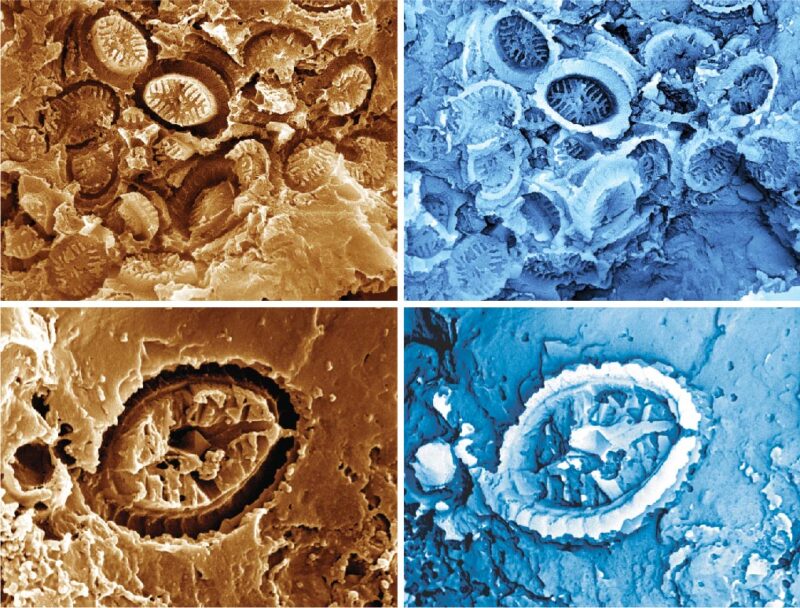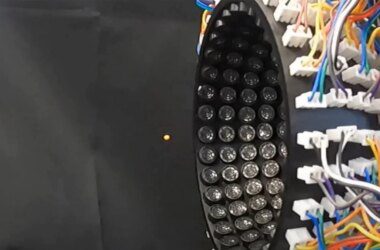
Les images montrent les empreintes d’une paroi cellulaire effondrée (une coccosphère) sur la surface d’un fragment de matière organique ancienne (à gauche) et les plaques individuelles (coccolithes) agrandies pour montrer la préservation exquise des structures à l’échelle submicronique (à droite). L’image bleue est inversée pour donner un moulage virtuel du fossile, c’est-à-dire pour montrer la forme tridimensionnelle originale. Les plaques originales ont été retirées du sédiment par dissolution, ne laissant derrière elles que les empreintes fantômes. Crédit : S.M. Slater, P. Bown / Science journal
Une équipe internationale de chercheurs a découvert un nouveau type de fossilisation.
La découverte de fossiles “fantômes” révèle la résilience du plancton aux épisodes de réchauffement climatique passés.
Une équipe internationale de scientifiques de l’University College London (UCL), du Musée suédois d’histoire naturelle, du Musée d’histoire naturelle (Londres) et de l’Université de Florence a découvert un type remarquable de fossilisation qui était resté presque entièrement inaperçu jusqu’à présent.
Les fossiles sont des empreintes microscopiques, ou “fantômes”, de plancton unicellulaire, appelé coccolithophores, qui vivait dans les mers il y a des millions d’années. Leur découverte révolutionne notre compréhension de la façon dont le changement climatique affecte le plancton dans les océans.

Nannofossile fantôme provenant des roches jurassiques du Yorkshire, Royaume-Uni. Crédit : S.M. Slater et al.
Les coccolithophores sont importants dans les océans d’aujourd’hui, car ils fournissent une grande partie de l’oxygène que nous respirons, soutiennent les réseaux alimentaires marins et emprisonnent le carbone dans les sédiments des fonds marins. Il s’agit d’un type de plancton microscopique qui entoure ses cellules de plaques calcaires dures, appelées coccolithes, et ce sont ces dernières qui se fossilisent normalement dans les roches.
La diminution de l’abondance de ces fossiles a été documentée lors de multiples épisodes de réchauffement climatique passés, suggérant que ce plancton a été sévèrement affecté par le changement climatique et l’acidification des océans. Cependant, une étude publiée aujourd’hui dans la revue Science présente de nouveaux enregistrements mondiaux de fossiles fantômes abondants provenant de trois Jurassic and Cretaceous warming events (94, 120, and 183 million years ago), suggesting that coccolithophores were more resilient to past climate change than was previously thought.

The individual plates are coccoliths. Credit: Images from Nannotax https://www.mikrotax.org/Nannotax3/
“The discovery of these beautiful ghost fossils was completely unexpected,” says Dr. Sam Slater from the Swedish Museum of Natural History. “We initially found them preserved on the surfaces of fossilized pollen, and it quickly became apparent that they were abundant during intervals where normal coccolithophore fossils were rare or absent – this was a total surprise!”
Despite their microscopic size, coccolithophores can be hugely abundant in the present ocean, being visible from space as cloud-like blooms. After death, their calcareous exoskeletons sink to the seafloor, accumulating in vast numbers, and forming rocks such as chalk.

The fossils are approximately 5 µm in length, 15 times narrower than the width of a human hair. Credit: S.M. Slater, P. Bown et al. / Science journal
“The preservation of these ghost nannofossils is truly remarkable,” says Professor Paul Bown (UCL). “The ghost fossils are extremely small ‒ their length is approximately five-thousandths of a millimeter, 15 times narrower than the width of a human hair! ‒ but the detail of the original plates is still perfectly visible, pressed into the surfaces of ancient organic matter, even though the plates themselves have dissolved away.”
The ghost fossils formed while the sediments at the seafloor were being buried and turned into rock. As more mud was gradually deposited on top, the resulting pressure squashed the coccolith plates and other organic remains together, and the hard coccoliths were pressed into the surfaces of pollen, spores, and other soft organic matter. Later, acidic waters within spaces in the rock dissolved away the coccoliths, leaving behind just their impressions – the ghosts.

Ghost nannofossils were found in rocks from global warming intervals where normal coccolithophore fossils were rare or absent. Credit: S.M. Slater, P. Bown, et al. / Science journal
“Normally, paleontologists only search for the fossil coccoliths themselves, and if they don’t find any then they often assume that these ancient plankton communities collapsed,” explains Professor Vivi Vajda (Swedish Museum of Natural History). “These ghost fossils show us that sometimes the fossil record plays tricks on us and there are other ways that these calcareous nannoplankton may be preserved, which need to be taken into account when trying to understand responses to past climate change.”
Professor Silvia Danise (University of Florence) says: “Ghost nannofossils are likely common in the fossil record, but they have been overlooked due to their tiny size and cryptic mode of preservation. We think that this peculiar type of fossilization will be useful in the future, particularly when studying geological intervals where the original coccoliths are missing from the fossil record.”

Ghost nannofossils were found globally, in rocks from three rapid warming events in Earth’s history (the T-OAE, OAE1a, and OAE2). Credit: S.M. Slater et al.
The study focused on the Toarcian Oceanic Anoxic Event (T-OAE), an interval of rapid global warming in the Early Jurassic (183 million years ago), caused by an increase in CO2-levels in the atmosphere from massive volcanism in the Southern Hemisphere. The researchers found ghost nannofossils associated with the T-OAE from the UK, Germany, Japan, and New Zealand, but also from two similar global warming events in the Cretaceous: Oceanic Anoxic Event 1a (120 million years ago) from Sweden, and Oceanic Anoxic Event 2 (94 million years ago) from Italy.
“The ghost fossils show that nannoplankton were abundant, diverse, and thriving during past warming events in the Jurassic and Cretaceous, where previous records have assumed that plankton collapsed due to ocean acidification,” explains Professor Richard Twitchett (Natural History Museum, London). “These fossils are rewriting our understanding of how the calcareous nannoplankton respond to warming events.”
Finally, Dr. Sam Slater explains: “Our study shows that algal plankton were abundant during these past warming events and contributed to the expansion of marine dead zones, where seafloor oxygen-levels were too low for most species to survive. These conditions, with plankton blooms and dead zones, may become more widespread across our globally warming oceans.”
Reference: “Global record of “ghost” nannofossils reveals plankton resilience to high CO2 and warming” by Sam M. Slater, Paul Bown, Richard J. Twitchett, Silvia Danise and Vivi Vajda, 19 May 2022, Science.
DOI: 10.1126/science.abm7330



